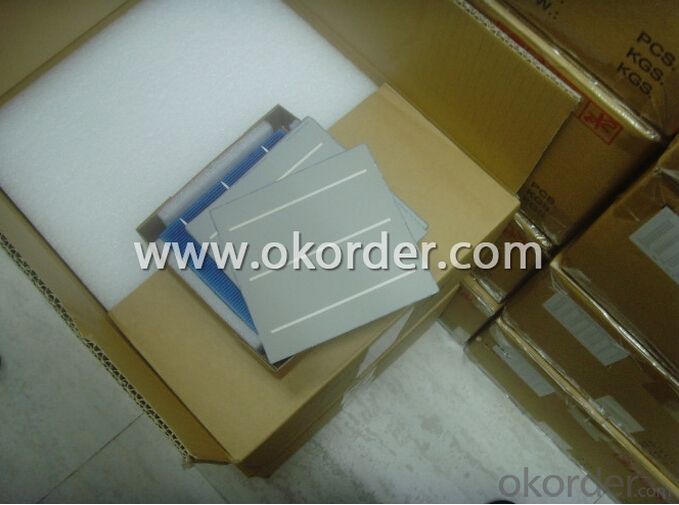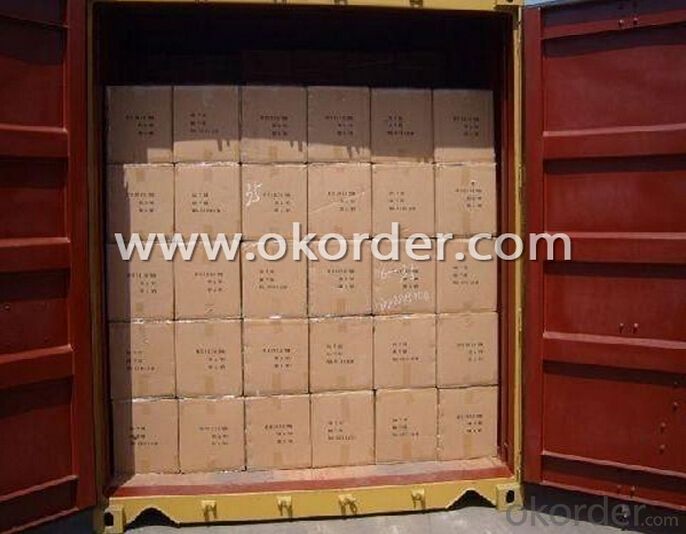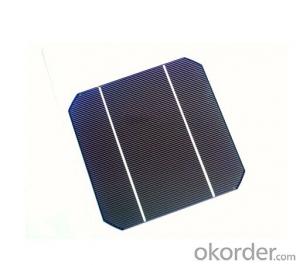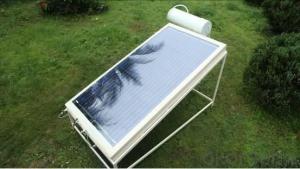Mono Solar Cells 2BB/3BB CNBM High Efficiency
- Loading Port:
- China main port
- Payment Terms:
- TT OR LC
- Min Order Qty:
- 4200 watt
- Supply Capability:
- 6000000 watt/month
OKorder Service Pledge
OKorder Financial Service
You Might Also Like
1.Product Description:
Specifications of Mono Solar Cells
Format : 156 mm × 156 mm ± 0.5 mm
Thickness: 210 μm ±40 μm
Front (-) : 1.5mm bus bars (silver),blue anti-reflection coating (silicon nitride)
Back (+) : 2.5mm wide soldering pads (silver) back surface field (aluminium)
2.Electrical Characteristic of Mono Solar Cells
Efficiency (%) | Pmpp (W) | Umpp (V) | Impp (A) | Uoc (V) | Isc (A) | FF (%) |
18.35 | 4.384 | 0.526 | 8.333 | 0.63 | 8.877 | 78.39% |
18.20 | 4.349 | 0.526 | 8.263 | 0.63 | 8.789 | 78.54% |
18.05 | 4.313 | 0.525 | 8.216 | 0.63 | 8.741 | 78.32% |
17.90 | 4.277 | 0.524 | 8.161 | 0.629 | 8.713 | 78.04% |
17.75 | 4.241 | 0.523 | 8.116 | 0.629 | 8.678 | 77.70% |
17.60 | 4.206 | 0.521 | 8.073 | 0.628 | 8.657 | 77.36% |
17.45 | 4.170 | 0.519 | 8.039 | 0.628 | 8.633 | 76.92% |
17.30 | 4.134 | 0.517 | 8.004 | 0.626 | 8.622 | 76.59% |
17.15 | 4.098 | 0.516 | 7.938 | 0.625 | 8.537 | 76.80% |
17.00 | 4.062 | 0.512 | 7.933 | 0.625 | 8.531 | 76.18% |
16.75 | 4.002 | 0.511 | 7.828 | 0.625 | 8.499 | 75.34% |
16.50 | 3.943 | 0.510 | 7.731 | 0.625 | 8.484 | 74.36% |
3.Advantage of Mono Solar Cells
1. High efficiency and High power.
2. Long-term electrical stability.
3. Lowest price and Fastest delivery.
4. Good quality and best service.
5. Bulk supply
6. Trusted Warranty
7. Big Sale
8. More than 25 years on the lifetime.
4.Usage and Applications of Mono Solar Cells
156X156mm mono solar cell made with good quality monocrystalline solar wafer, produced by listed factories in the world, We are able to supply customers more than 300MW OEM solar cells and 100MW solar panels annually.We are commited to service every customer as our honorable clients to enjoy the green and clean energy. With mono solar cell from CNBM, you can enjoy the most professional technical support and the best service!
Our Cells can greatly improve the performance of Solar Modules.
5.Packaging & Delivery of Mono Solar Cells
Carton Box Package and Deliver by air. It should be noticed that it should be avoid of water, sunshine and moist.


- Q:Can solar cells be used to power data centers?
- Yes, solar cells can be used to power data centers. With advancements in solar technology, it is possible to generate a significant amount of electricity from solar panels, making them a viable option for powering energy-intensive facilities like data centers. However, due to the high energy demands of data centers, it may require a large-scale solar installation and efficient energy storage systems to ensure uninterrupted power supply.
- Q:Can solar cells be used in military vehicles?
- Yes, solar cells can be used in military vehicles. They can provide an alternative source of energy to power various systems and equipment, reducing reliance on traditional fuel sources and enabling greater operational flexibility and sustainability. Additionally, solar cells can help extend the range and endurance of military vehicles in remote or austere environments where access to conventional fuel supplies may be limited.
- Q:How are solar cells integrated into building designs?
- Solar cells can be integrated into building designs through various methods such as rooftop installations, solar facades, and building-integrated photovoltaics (BIPV). These methods involve incorporating solar panels into the structure of the building, either on the roof or as part of the facade, allowing for the generation of clean and renewable electricity while seamlessly blending with the overall architectural design.
- Q:What is the impact of solar cells on reducing electricity bills?
- Solar cells have a significant impact on reducing electricity bills as they harness the power of the sun to generate clean and renewable energy. By producing electricity on-site, solar cells can offset a considerable portion of a household's or business's energy consumption, leading to substantial savings on monthly electricity bills. Moreover, excess energy generated by solar cells can be fed back into the grid, allowing homeowners and businesses to earn credits or even receive payments for the surplus energy they contribute. Overall, solar cells offer a sustainable and cost-effective solution to reduce electricity bills and promote energy independence.
- Q:What is the role of batteries in solar cell systems?
- The role of batteries in solar cell systems is to store the excess energy generated by the solar panels during the day for use during periods of low or no sunlight, such as at night or during cloudy weather. This allows for a continuous and reliable power supply from solar energy.
- Q:How do solar cells handle power quality issues?
- Solar cells do not directly handle power quality issues. However, inverters are used in solar power systems to convert the direct current (DC) generated by solar cells into alternating current (AC) that can be used in homes and businesses. These inverters often have built-in features to address power quality issues such as voltage fluctuations, harmonic distortions, and frequency variations. Additionally, grid-tied solar systems can rely on the electrical grid itself to handle power quality issues, as any excess power generated by solar cells can be fed back into the grid, ensuring a stable and reliable power supply.
- Q:How does the photovoltaic cells work?
- Photovoltaic solar cells are the thin silicon chips that transform the sunlight into electricity in a scientfic way.
- Q:How do solar cells perform in areas with limited space for installation?
- Solar cells can still perform efficiently in areas with limited space for installation through the use of innovative technologies such as rooftop and building-integrated photovoltaics. These systems maximize the use of available space, allowing solar cells to generate electricity even in compact urban environments. Additionally, advancements in solar cell design and efficiency have made it possible to produce more power from smaller areas, further optimizing electricity generation in limited spaces.
- Q:Can solar cells be used for powering desalination plants?
- Yes, solar cells can be used for powering desalination plants. Solar energy can be harnessed by solar cells to generate electricity, which can then be used to power the various components of a desalination plant, such as pumps and filtration systems. This allows for a sustainable and environmentally friendly approach to desalination, utilizing renewable energy sources to convert seawater into potable water.
- Q:Can solar cells be used to power outdoor signage?
- Yes, solar cells can be used to power outdoor signage. Solar cells convert sunlight into electricity, which can then be used to power various devices, including outdoor signage. This approach is eco-friendly, as it relies on renewable energy sources, and it can also be cost-effective in the long run by reducing electricity bills.
1. Manufacturer Overview |
|
|---|---|
| Location | |
| Year Established | |
| Annual Output Value | |
| Main Markets | |
| Company Certifications | |
2. Manufacturer Certificates |
|
|---|---|
| a) Certification Name | |
| Range | |
| Reference | |
| Validity Period | |
3. Manufacturer Capability |
|
|---|---|
| a)Trade Capacity | |
| Nearest Port | |
| Export Percentage | |
| No.of Employees in Trade Department | |
| Language Spoken: | |
| b)Factory Information | |
| Factory Size: | |
| No. of Production Lines | |
| Contract Manufacturing | |
| Product Price Range | |
Send your message to us
Mono Solar Cells 2BB/3BB CNBM High Efficiency
- Loading Port:
- China main port
- Payment Terms:
- TT OR LC
- Min Order Qty:
- 4200 watt
- Supply Capability:
- 6000000 watt/month
OKorder Service Pledge
OKorder Financial Service
Similar products
New products
Hot products
Hot Searches
Related keywords





























